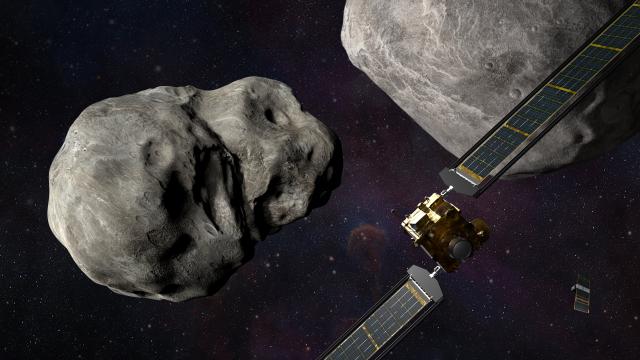NASA’s DART spacecraft is on track to hit a non-threatening asteroid today at 9:14 a.m. AEST, in what is an important demonstration of a planetary defence strategy. But space is hard, and DART, travelling at 24,140 km per hour, could whiz past the 158.50 m-wide object. Here’s what would happen should that unlucky scenario arise.
Two broad possible outcomes exist for today’s Double Asteroid Redirection Test, or DART (which you can watch live at this link).
Ideally, the 624 kg spacecraft will smash into Dimorphos, the smaller member of the Didymos binary asteroid system, and get annihilated in the process. DART’s onboard camera, DRACO (Didymos Reconnaissance and Asteroid Camera for Optical navigation), will be capturing one image each second until the bitter end, so we should go from seeing progressively larger and clearer views of Dimorphos to a blank screen. The final image from DRACO will be taken as DART is about 2.5 seconds from impact. We should expect ground controllers to declare “loss of signal,” or “impact confirmed,” followed by a rapturous cheer from the control room.
Importantly, these verbal confirmations will arrive prior to the visual confirmation, as it takes roughly eight seconds for NASA’s computers to process DRACO images upon receipt of signal, as NASA officials explained during a press briefing on September 22. So don’t be surprised or alarmed if you continue to see images of Dimorphos immediately after controllers declare a mission success.
More grimly, the $US308 ($428) million DART probe could miss its target altogether. This could happen, as getting objects to intersect so far into deep space is challenging. NASA is using a new autonomous navigation system, called SMART Nav, and the unproven system will need to distinguish Dimorphos from Didymos (yes, the possibility exists that DART will hit the wrong asteroid). Full autonomy in the final moments of the mission is a requirement, as messages from Earth are now taking 38 seconds to reach the spacecraft. Finally, a series of course correction manoeuvres will need to continually keep DART on track.
Should DART fly past Dimorphos, we can expect to see DRACO images of deep space and no declaration of “loss of signal.” DART, moving at 6 km per second can’t just slam the brakes, spin the wheel, and make another attempt. Rather, it’ll keep venturing out deeper into the solar system. The spacecraft launched in November 2021 and is now 11 million km from Earth.
In the seconds and minutes after a possible miss, “we’re going to sit back down on our seats” and “start preserving all the data about why we missed,” Elena Adams, DART systems engineer, told reporters during the September 22 briefing. This will include data gathered by NASA’s Deep Space Network, a global network of ground-based radio antennas that support interplanetary spacecraft missions. The teams will also want to collect data from LICIACube, a 14-kilogram probe travelling alongside DART. The Italian-built probe was dispatched by DART several weeks ago and is equipped with two cameras, LUKE and LEIA.
Speaking at the same briefing, Lindley Johnson, manager of NASA’s Near-Earth Object Observations program, echoed Adams’s sentiments, saying that, “in the unlikely event” that DART fails to hit its target, the teams will try to “figure out what happened and why we missed.” The teams will dive into the data and also “safe” the spacecraft such that it’s “ready for future use,” he explained. Adams said the ground teams will want to conserve DART’s hydrazine propellant as part of these safing operations.
Encouragingly, all would not be lost, as the DART team would look for other potential asteroids for the spacecraft to hit, Adams added. There’s no guarantee that this will happen, but it would provide a glimmer of hope in the event the DART mission doesn’t go as planned tonight.
Dimorphos poses no risk to Earth, so a failed mission wouldn’t mean that our planet is in any danger. By smashing DART into the asteroid, scientists are hoping to alter its speed by a factor of 1%, which is enough to change its orbit. Eventually, a fully developed kinetic impactor could protect Earth from bona fide asteroid threats.
More: Why DART Is the Most Important Mission Ever Launched to Space
